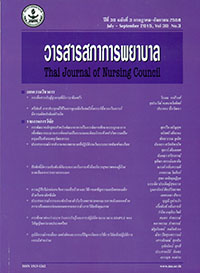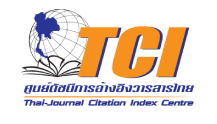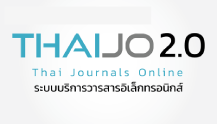การศึกษาช่องว่างระหว่างการรับรู้และการปฏิบัติตามแนวทาง SIMPLE ของวิสัญญีพยาบาลประเทศไทย
Keywords:
ช่องว่าง, การรับรู้และการปฏิบัติ, SIMPLE, วิสัญญีพยาบาล, gap, perception and practice, anaesthetic nursesAbstract
บทคัดย่อ: วัตถุประสงค์: 1) ศึกษาช่องว่างระหว่างการรับรู้และการปฏิบัติตามแนวทาง SIMPLE ของวิสัญญีพยาบาล 2) เปรียบเทียบช่องว่างระหว่างการรับรู้และการปฏิบัติตามแนวทาง SIMPLE ของวิสัญญีพยาบาลตามลักษณะส่วนบุคคลและองค์ประกอบด้านการปฏิบัติงาน
การออกแบบการวิจัย: การศึกษาเชิงเปรียบเทียบ
การดำเนินการวิจัย: เลือกกลุ่มตัวอย่างแบบเจาะจง คือ วิสัญญีพยาบาลที่ร่วมประชุม วิชาการชมรมวิสัญญีพยาบาลแห่งประเทศไทย ครั้งที่ 11 จำนวน 950 คน เครื่องมือที่ใช้ เป็นแบบสอบถาม วิเคราะห์เปรียบเทียบโดยใช้สถิติ t-test และ One way ANOVA
ผลการวิจัย: พบว่า ช่องว่างระหว่างการรับรู้และการปฏิบัติตามแนวทาง SIMPLE ของ วิสัญญีพยาบาลอยู่ในระดับที่แคบมาก ( =0.090, SD=0.107) แสดงถึงวิสัญญีพยาบาล มีการรับรู้และการปฏิบัติด้านวิสัญญีที่มีความปลอดภัยสูงโดยเฉพาะด้านการจัดการเมื่อ เกิดภาวะไม่พึงประสงค์มีช่องว่างแคบมากที่สุด
ผลการวิเคราะห์เปรียบเทียบ พบว่า วิสัญญีพยาบาลที่ปฏิบัติงานในที่มีวิสัญญีแพทย์ ประจำโรงพยาบาลมีช่องว่างระหว่างการรับรู้และการปฏิบัติตามแนวทาง SIMPLE แคบกว่า ผู้ปฏิบัติงานในที่ไม่มีวิสัญญีแพทย์ และวิสัญญีพยาบาลที่มีประสบการณ์การให้ยาระงับความ รู้สึกมากกว่า 50 รายต่อปี มีช่องว่างที่แคบกว่าผู้มีประสบการณ์น้อยกว่า 50 รายต่อปี รวมทั้ง วิสัญญีพยาบาลที่ปฏิบัติงานในโรงพยาบาลระดับตติยภูมิมีช่องว่างแคบที่สุด สำหรับลักษณะ ส่วนบุคคลและองค์ประกอบด้านการปฏิบัติงานอื่นๆ ที่แตกต่างกัน พบว่า วิสัญญีพยาบาล มีช่องว่างระหว่างการรับรู้และการปฏิบัติตามแนวทาง SIMPLE ไม่แตกต่างกัน
ข้อเสนอแนะ: วิสัญญีพยาบาลควรมีประสบการณ์การให้ยาระงับความรู้สึกอย่างน้อย 50 รายต่อปี และศึกษาดูงานในโรงพยาบาลระดับที่สูงกว่า รวมทั้งควรกระจายวิสัญญีแพทย์ ให้ครอบคลุมทุกโรงพยาบาล
Abstract: Objective: To study Thai anaesthetic nurses’ gap between perception and practice of the SIMPLE approach based on their personal characteristics and professional factors.
Design: Comparative study.
Implementation: The subjects were 950 anaesthetic nurses purposively sampled from the participants of Thailand’s Eleventh Anaesthetists’ Association Conference. Data were collected through a questionnaire and comparatively analysed using t-test statistics and one-way ANOVA.
Results: The study showed the gap between the anaesthetic nurses’ perception and practice of the SIMPLE approach to be very narrow ( = 0.090, SD = 0.107). In particular, the gap was narrowest in the area of ability to handle unforeseen conditions. This meant that the subjects possessed a high degree of anaesthesia-related practice and safety awareness.
The comparative study results showed that the gap between perception and practice of the SIMPLE approach was narrower amongst anaesthetic nurses working in hospitals with anaesthetic physicians than amongst those working in hospitals without anaesthetic physicians. Next, the gap was observed to be narrower amongst anaesthetic nurses with more than 50-case-per-year aneasthesia administration experience than amongst those administering anaesthesia to fewer than 50 cases per year. Moreover, the gap was found narrowest amongst anaesthetic nurses working in tertiary hospitals. Personal characteristics and professional factors, in contrast, were found in no significant relation to the gap between perception and practice of the SIMPLE approach.
Recommendations: It is recommended that, for accumulation of experience, anaesthetic nurses be assigned to at least 50 anaesthesia administration cases per year and encouraged to attend training programmes at more advanced hospitals. In addition, it is essential that anaesthetic physicians be stationed at all hospitals.






